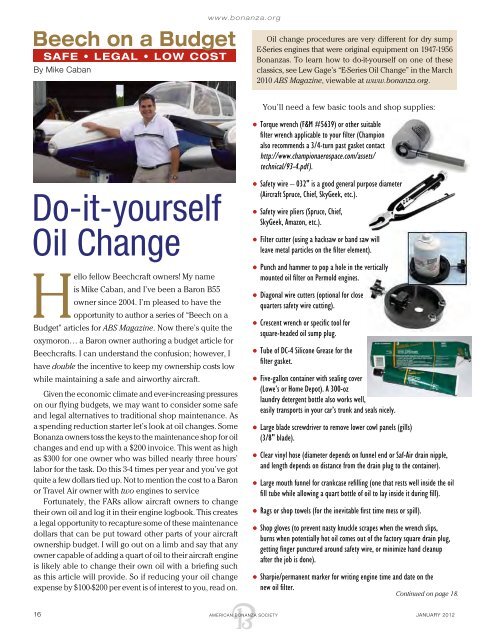A New Way of Flight Training⦠- American Bonanza Society
A New Way of Flight Training⦠- American Bonanza Society
A New Way of Flight Training⦠- American Bonanza Society
You also want an ePaper? Increase the reach of your titles
YUMPU automatically turns print PDFs into web optimized ePapers that Google loves.
Beech on a Budget<br />
Safe • Legal • Low Cost<br />
By Mike Caban<br />
www.bonanza.org<br />
Oil change procedures are very different for dry sump<br />
E-Series engines that were original equip ment on 1947-1956<br />
<strong>Bonanza</strong>s. To learn how to do-it-yourself on one <strong>of</strong> these<br />
classics, see Lew Gage’s “E-Series Oil Change” in the March<br />
2010 ABS Magazine, viewable at www.bonanza.org.<br />
You’ll need a few basic tools and shop supplies:<br />
c Torque wrench (F&M #5639) or other suitable<br />
filter wrench applicable to your filter (Champion<br />
also recommends a 3/4-turn past gasket contact<br />
http://www.championaerospace.com/assets/<br />
technical/93-4.pdf).<br />
Do-it-yourself<br />
Oil Change<br />
Hello fellow Beechcraft owners! My name<br />
is Mike Caban, and I’ve been a Baron B55<br />
owner since 2004. I’m pleased to have the<br />
opportunity to author a series <strong>of</strong> “Beech on a<br />
Budget” articles for ABS Magazine. Now there’s quite the<br />
oxymoron… a Baron owner authoring a budget article for<br />
Beechcrafts. I can understand the confusion; however, I<br />
have double the incentive to keep my ownership costs low<br />
while maintaining a safe and airworthy aircraft.<br />
Given the economic climate and ever-increasing pressures<br />
on our flying budgets, we may want to consider some safe<br />
and legal alternatives to traditional shop maintenance. As<br />
a spending reduction starter let’s look at oil changes. Some<br />
<strong>Bonanza</strong> owners toss the keys to the maintenance shop for oil<br />
changes and end up with a $200 invoice. This went as high<br />
as $300 for one owner who was billed nearly three hours’<br />
labor for the task. Do this 3-4 times per year and you’ve got<br />
quite a few dollars tied up. Not to mention the cost to a Baron<br />
or Travel Air owner with two engines to service<br />
Fortunately, the FARs allow aircraft owners to change<br />
their own oil and log it in their engine logbook. This creates<br />
a legal opportunity to recapture some <strong>of</strong> these maintenance<br />
dollars that can be put toward other parts <strong>of</strong> your aircraft<br />
ownership budget. I will go out on a limb and say that any<br />
owner capable <strong>of</strong> adding a quart <strong>of</strong> oil to their aircraft engine<br />
is likely able to change their own oil with a briefing such<br />
as this article will provide. So if reducing your oil change<br />
expense by $100-$200 per event is <strong>of</strong> interest to you, read on.<br />
c Safety wire – 032" is a good general purpose diameter<br />
(Aircraft Spruce, Chief, SkyGeek, etc.).<br />
c Safety wire pliers (Spruce, Chief,<br />
SkyGeek, Amazon, etc.).<br />
c Filter cutter (using a hacksaw or band saw will<br />
leave metal particles on the filter element).<br />
c Punch and hammer to pop a hole in the vertically<br />
mounted oil filter on Permold engines.<br />
c Diagonal wire cutters (optional for close<br />
quarters safety wire cutting).<br />
c Crescent wrench or specific tool for<br />
square-headed oil sump plug.<br />
c Tube <strong>of</strong> DC-4 Silicone Grease for the<br />
filter gasket.<br />
c Five-gallon container with sealing cover<br />
(Lowe’s or Home Depot). A 300-oz<br />
laundry detergent bottle also works well,<br />
easily transports in your car’s trunk and seals nicely.<br />
c Large blade screwdriver to remove lower cowl panels (gills)<br />
(3/8" blade).<br />
c Clear vinyl hose (diameter depends on funnel end or Saf-Air drain nipple,<br />
and length depends on distance from the drain plug to the container).<br />
c Large mouth funnel for crankcase refilling (one that rests well inside the oil<br />
fill tube while allowing a quart bottle <strong>of</strong> oil to lay inside it during fill).<br />
c Rags or shop towels (for the inevitable first time mess or spill).<br />
c Shop gloves (to prevent nasty knuckle scrapes when the wrench slips,<br />
burns when potentially hot oil comes out <strong>of</strong> the factory square drain plug,<br />
getting finger punctured around safety wire, or minimize hand cleanup<br />
after the job is done).<br />
c Sharpie/permanent marker for writing engine time and date on the<br />
new oil filter.<br />
Continued on page 18.<br />
16 AMERICAN BONANZA SOCIETY JANUARY 2012

















